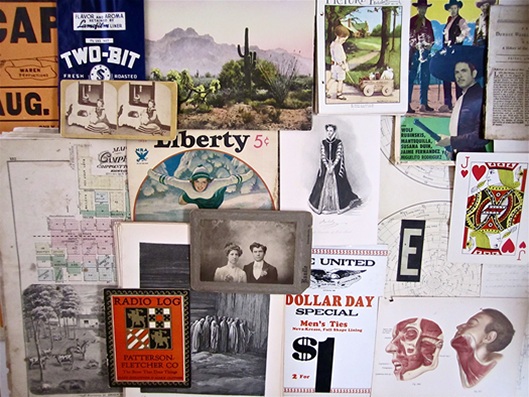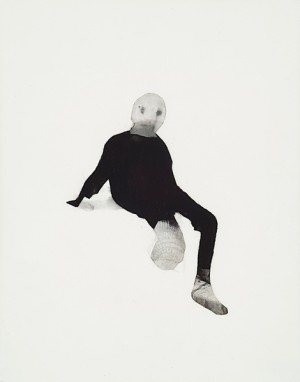
click image to read more
It starts off with a conversation between Kolaj contributor Edvard Derkert and his friend Gunnar, a painter in his late fifties working in a sort of abstract expressionistic style. They talk about two different pieces that have a lot in common, at least visually. But something is also confronting both works and their creators’ ideas. They are comparing a painting and a digital collage.
“What Gunnar saw on the screen on my laptop he found unreal. Not real in the sense of realistic. Like photorealism. Unreal, because of the fact that there is nothing to touch, no smell of turpentine, just pixels on a screen!”
This conversation must be seen as a pretext, a starting point for Derkert to elaborate on the perception and legitimacy of digital collage using unexpected detours and colorful analogies.
Not so long ago, Portland, Oregon artist Liz Cohn inherited 125 decks of playing cards from her father-in-law’s private collection. She decided to use the large amount of cards as materials for a mail art collaboration project.

In our first issue, writer Jp King asked Montreal artist Sophie Jodoin why the human figure is so important in her work, she responded: “its complexity, psychologically and physically, everything that it might reveal, hold back, hide, deny, bare, resist…” Jodoin’s work has the capacity to draw the viewer in to its intimate dramas through the sensitive and proficient handling of her thought provoking subjects. Equally conceptual and representational, her drawn series of works can take up to two years to realize. “Close Your Eyes” is conceived as a long continuous thread echoing the course of one’s life—a collection of narratives and struggles encountered by simply living.
The Close your eyes exhibition is conceived as a long continuous thread echoing the course of one’s life—a collection of narratives and struggles encountered by simply living. It covers a span of four years and consists of three body of works: Small Dramas & Little Nothings, Charred and Vigils. Materially, it includes black and white drawings, collages, video, a sculptural piece and tables with artifacts.
In her masterful collages, Eva Lake creates wondrous new wholes from fragmented parts. Included in Judd Women Targets are photomontages from three bodies of work, The Judd Montages, Anonymous Women, and the Targets series.
This exhibition marks the inaugural showing of Lake’s Judd Montages, some of her earliest works. The artist found the Judd images used in these collages in an illegal sublet in New York, where she lived for ten years. The apartment had belonged to an art dealer who left behind an art magazine from the 1960s featuring Donald Judd. Inspired by Judd’s stark forms, Lake held onto the magazine for over two decades before eventually cutting into it. In creating the Judd Montages, the artist wanted to add vitality to works famous for their austerity and non-content. In doing so, Lake is playing with works from the canon of art history that are not initially meant to be played with. This exercise results in dazzlingly colorful montages that re-imagine Judd’s minimalist sculptures as the protagonists in various glamorous and often dreamlike landscapes.
This month, BLAST Gallery in Teaneck, NJ, presents an exhibition of the work of artists Audrey Smith and Maggie Kleinpeter.
Around 2007 Audrey Smith began creating collages in a Moleskine sketchbook as a creative exercise. A year into the project she began to take another serious look at collage and mixed media art, and it blossomed into a new creative focus. Her work has evolved from simple abstract constructions to a more narrative and surrealistic style. She combines vintage and antique medical and science illustration, photographs, and advertising with rich color, patterns, and type. Her work has been exhibited in the United States and Europe and has been published in books and art periodicals.
This series of art is the intersection between Maggie Kleinpeter’s creative life as a painter and her design work for Supermaggie, a screen printed apparel company she operates with Michael Pittard. Incorporating her drawings and photographs along with vintage artwork, these whimsical compositions are created by artfully layering the screen printed images used on Supermaggie apparel. In these artworks the images are transformed from simple prints to layered and textured dreamlike scenarios with the suggestion of a narrative.
Punk Surrealist artist Winston Smith, known for his sulfuric political collages, will be talking about surrealism, art and anarchy with V.Vale, Penelope Rosemont and Ron Sakolsky. This panel discussion is part of the 2012 Bay Area Anarchist Book Fair, presented by Bound Together Bookstore in San Fransisco.
Plant Life of the Pacific World is a controversial exhibition of delicate flower and plant forms assembled from collaged photographs of nuclear explosions. In this new work Noronha Feio plays with the relationships between beauty, conflict, the foreign and the domestic.
Each work has been classified in accordance with American botanist E. D. Merrill’s book from which the exhibition takes its name. Originally published for military use in 1945, the book’s dry classification of flora is transformed by Noronha Feio into an explosive revelry of intense, amoebic forms. Plant Life of the Pacific World defuses one of the most recognisable symbols of destruction, horror and power to create a sumptuous taxonomy combining the nuclear mutations of popular fiction, the evolutionary mutations of Darwin’s Galapagos and an imagined botany of Bikini Atoll, whose use as nuclear testing grounds followed the book’s publication.